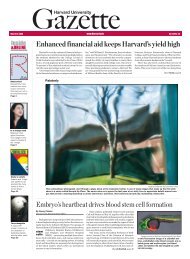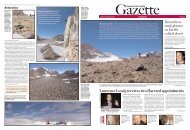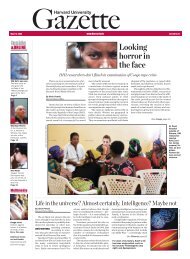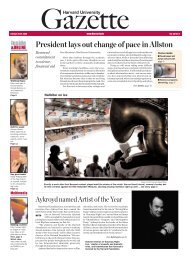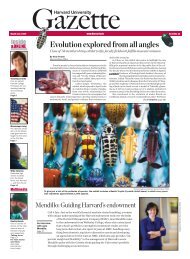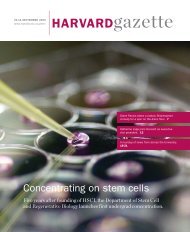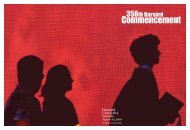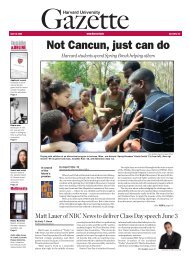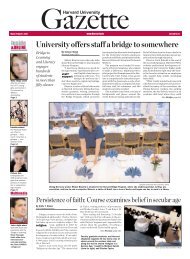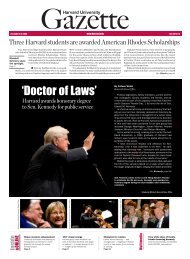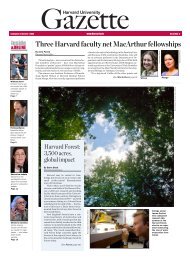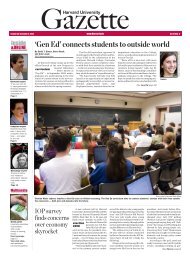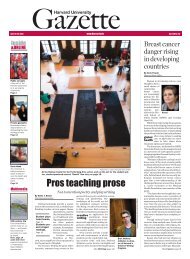Hansjörg Wyss gives $125M to create institute - Harvard News ...
Hansjörg Wyss gives $125M to create institute - Harvard News ...
Hansjörg Wyss gives $125M to create institute - Harvard News ...
You also want an ePaper? Increase the reach of your titles
YUMPU automatically turns print PDFs into web optimized ePapers that Google loves.
8 / <strong>Harvard</strong> University Gazette Oc<strong>to</strong>ber 9-15, 2008<strong>Wyss</strong>(Continued from page 1)computer science, robotics, medicine, andsurgery from <strong>Harvard</strong>’s Schools and affiliatedhospitals, as well as from neighboringuniversities. The multidisciplinary effortwill function as the corners<strong>to</strong>ne of <strong>Harvard</strong>’sbroader efforts in bioengineering, and willbuild on many elements of the <strong>Harvard</strong> Institutefor Biologically Inspired Engineering(www.hibie.harvard.edu), which was<strong>create</strong>d with seed support from the <strong>Harvard</strong>University Science and Engineering Committeein response <strong>to</strong> a faculty-developedplan for this burgeoning discipline.<strong>Wyss</strong>’ gift will provide funds for seven endowedfaculty positions, as well as major operatingfunds for the <strong>institute</strong>. The locus ofthe <strong>Wyss</strong> Institute will be in the first sciencecomplex currently under construction on<strong>Harvard</strong>’s campus in the Alls<strong>to</strong>n neighborhoodof Bos<strong>to</strong>n.“I am humbled <strong>to</strong> have the opportunity <strong>to</strong>contribute in a meaningful way <strong>to</strong> efforts thatI firmly believe will change the future courseof science and medicine,” <strong>Wyss</strong> said. “Littledid I dream when I began my career in engineeringthat we would reach a point whereengineers and biologists would be using nature’stemplates <strong>to</strong> <strong>create</strong> solutions <strong>to</strong> ourmedical and environmental challenges.”President Faust and Provost Steven E.Hyman, <strong>to</strong>gether with Dean Jeffrey Flier,Dean Michael Smith, and former DeanVenkatesh Narayanamurti — of the <strong>Harvard</strong>Medical School, Faculty of Arts and Sciences,and School of Engineering and AppliedSciences (SEAS), respectively — announcedthat Donald Ingber, Judah FolkmanProfessor of Vascular Biology at <strong>Harvard</strong>Medical School and Children’s HospitalBos<strong>to</strong>n, and professor of bioengineeringat SEAS, will serve as the <strong>Wyss</strong> Institute’sfounding direc<strong>to</strong>r.“Hansjörg <strong>Wyss</strong>’ vision for the potentialinherent in newly emerging areas of bioengineeringwill allow <strong>Harvard</strong> <strong>to</strong> integratethe worlds of biology and engineering <strong>to</strong> developnontraditional solutions <strong>to</strong> seeminglyinsurmountable challenges,” said Hyman.“Don Ingber’s leadership and commitment<strong>to</strong> exploring these possibilities will makethis vision a reality.”Hyman noted that the establishment ofthe <strong>Wyss</strong> Institute follows <strong>Harvard</strong>’s “commitment<strong>to</strong> the overall growth of engineeringat <strong>Harvard</strong> — exemplified by changing thestatus of the former Division of Engineering<strong>to</strong> a School of Engineering — but in the contex<strong>to</strong>f a liberal arts-focused research institution.With respect <strong>to</strong> bioengineering in particular,we are at a wonderful intellectual inflectionpoint where we’re beginning <strong>to</strong> see anew generation of bioengineering in which Ithink no one has an advantage, and where wewill provide very substantial intellectualpartnerships for such activities as our StemCell Institute and for the Systems Biology activities.Those partnerships might, for example,”he said, “enable us <strong>to</strong> convert new basicdiscoveries in<strong>to</strong> a host of treatments forhuman beings suffering with illnesses.”In expressing his gratitude <strong>to</strong> <strong>Wyss</strong>, Ingbersaid that “Hansjörg <strong>Wyss</strong> is a visionaryengineer and entrepreneur who understandsthat transformative change requiresrisk-taking and breaking down boundariesamong existing disciplines. We are indebted<strong>to</strong> him for his generosity, which will enableengineers, scientists, physicians, andindustrial collabora<strong>to</strong>rs <strong>to</strong> work across institutionsand disciplines at a level never beforepossible in an academic setting.”David Mooney, Gordon McKay Professorof Bioengineering at SEAS and co-chair of<strong>Harvard</strong>’s bioengineering working group,said, “I am particularly excited that this giftwill allow us <strong>to</strong> <strong>create</strong> an interdisciplinarycommunity of scholars who will work <strong>to</strong>gether<strong>to</strong> both develop novel technologiesand <strong>create</strong> a foundation for bioengineeringbased on a fundamental knowledge of howliving systems function.”Purpose and missionThe mission of the Hansjörg <strong>Wyss</strong> Institutefor Biologically Inspired Engineering is<strong>to</strong> discover the engineering principles thatnature uses <strong>to</strong> build living things, and <strong>to</strong> harnessthese insights <strong>to</strong> <strong>create</strong> biologically inspiredmaterials, devices, and control technologies<strong>to</strong> address unmet medical needsworldwide and bring about a more sustainableworld.Over the past decade in particular, engineering,biology, medicine, and the physicalsciences have increasingly converged.Through revolutionary advances in nanotechnology,genetics, and cell engineering,it is now possible <strong>to</strong> manipulate individuala<strong>to</strong>ms, genes, molecules, and cells one at atime, and <strong>to</strong> <strong>create</strong> artificial biological systems.Simultaneous progress in materialsscience, molecular biology, and tissue engineeringhas enabled scientists <strong>to</strong> developsynthetic materials, microdevices, and computationalstrategies <strong>to</strong> manipulate cellfunction, guide tissue formation, and controlcomplex organ physiology. As a result ofthese developments, the boundary betweenliving and nonliving systems is beginning <strong>to</strong>break down.The <strong>Wyss</strong> Institute will leverage theseadvances and facilitate new breakthroughsby advancing the science and engineeringnecessary <strong>to</strong> develop biomimetic materials,microdevices, microrobots, and innovativedisease-reprogramming technologies thatemulate how living cells and tissues self-organizeand naturally regulate themselves. Adeeper understanding of how living systemsbuild, recycle, and control also will ultimatelylead <strong>to</strong> more efficient bioinspiredways of converting energy, controlling manufacturing,improving the environment, andcreating a more sustainable world.Faculty and programsThe <strong>Wyss</strong> Institute will form a communityof engineers, scientists, and clinicians,and provide them with the resources necessary<strong>to</strong> pursue innovative, multidisciplinary,forward-looking research that will spur thedevelopment of transformative new technologiesand therapies.The <strong>institute</strong> will focus on fundamental,science-driven technology development inthe newly emerging fields of synthetic biology,biological control, and living materials.The Synthetic Biology Program will developgenetically engineered componentparts and circuits necessary <strong>to</strong> build programmableself-assembling nanomaterialsand integrated multifunctional living microdevices.The Biological Control Group will devisecontrol strategies that can “reboot” diseasedtissues and organs, as well as biologically inspiredalgorithms for robotic control.The Living Materials Program will harnessthe design principles that govern howliving cells, tissues, and organs exhibit theirnovel material properties and coupled biocatalyticfunctions, with the goal of fabricatingself-organizing biomimetic materialsand devices for both medical and nonmedicalapplications.The <strong>Wyss</strong> Institute will also incorporatean Advanced Technology Core, composed oftechnical experts with extensive expertisein genetic engineering, nanotechnology, microfabrication,materials science, and othercritical technologies, who move among differentfaculty labora<strong>to</strong>ries pursuing problemsuntil they are solved and useful technologiesare <strong>create</strong>d. The <strong>institute</strong>’s facultywill translate these new technologies in<strong>to</strong>commercial products and therapies throughpartnerships with industrial and clinicalcollabora<strong>to</strong>rs. The <strong>Wyss</strong> Institute also willsupport clinical faculty researchers who willidentify critical clinical challenges, conductresearch and development activities necessary<strong>to</strong> solve these problems, and help <strong>to</strong>bring these technologies back in<strong>to</strong> the clinic.Such an environment, free of disciplinaryboundaries, will foster the training of a newgeneration of students and fellows who fullyunderstand how <strong>to</strong> work across disciplines,and how <strong>to</strong> learn from the power of nature’sinnovations <strong>to</strong> advance bioengineering andmedicine.STATEMENT OF OWNERSHIP



